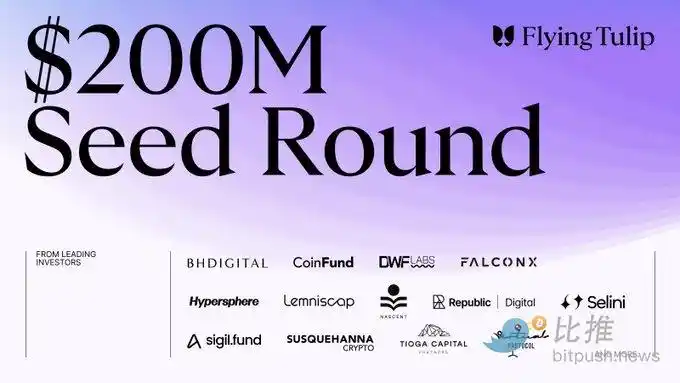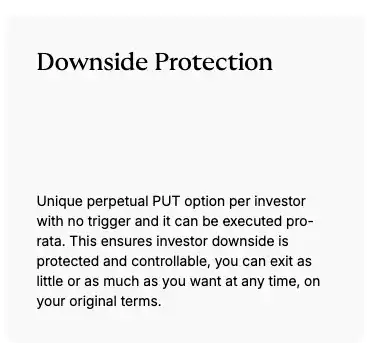Raising $200 million, DeFi father AC is back with Flying Tulip in a high-profile manner
Original title: "The Man Is Back! This time we want to raise a billion US dollars"
Original source: BitpushNews
When everyone thought Andre Cronje had faded out of the crypto circle, the legendary figure known as the "father of DeFi" is back. This time, he brought a new project - Flying Tulip, which today announced the completion of $200 million in financing and plans to launch a token public sale.
 – >
– >
what's even more special is that this public sale comes with a mechanism that has never been seen before: users can burn tokens and get their principal back at any time. This means that the downside risk of participants has "bottom line protection", while the upside return is still not capped.
Who is Andre Cronje?
If you've lived through DeFi summer in 2020, you've definitely heard his name.
 – >
– >
Cronje is the founder of Yearn Finance (YFI) – a legendary developer who started the DeFi craze with just code. YFI was once hailed as the "fairest token" because he didn't set aside any shares for himself at the time.
But after several project hits, community strife, and safety incidents, Cronje faded into the public eye in 2022. To this day, he takes the Flying Tulip "out of the mountain again".
What is Flying Tulip?
Editor's interpretation: "Flying Tulip" literally means "flying tulip". Tulips are the most famous bubble symbol in financial history (the 17th-century "tulip mania" was the earliest speculative bubble).
Cronje named the project Flying Tulip, which is a bit self-deprecating and a bit declarative: the crypto world may be like a tulip, but this time, he wants to make it really "fly". In other words, Flying Tulip wants to make things that used to represent "bubbles" more stable, realistic, and vibrant through on-chain mechanisms.
Judging from the official documentation, Flying Tulip hopes to create a full-chain financial platform that puts the functions that many crypto users are familiar with - stablecoins, lending, spot trading, derivatives, options, and insurance - all in one system.
To put it simply, it wants to be a "one-stop DeFi platform" that allows users to:
· Deposit coins to earn income;
· Borrowing coins for leverage;
· Go long and short;
· Even hedge risks with on-chain insurance.
And all of this is done in a unified account system without the need to switch between different platforms frequently.
A token offering
most eye-catching thing this time is Flying Tulip's "Onchain Redemption Right".
 – >
– >
Traditionally, once a user participates in a token public sale, their money is locked regardless of the price of the coin.
However, Flying Tulip provides a "programmatic redemption" mechanism -
all participants can burn their $FT tokens at any time to get back their invested principal (such as ETH).
The system automatically returns funds from a separate on-chain reserve pool. This design is a bit like an on-chain insurance mechanism, which not only ensures that investors will not "lose money to the end" while retaining room for growth.
However, it should be noted that the official also reminds that this is not a "guaranteed return to capital" or "deposit insurance" - the size of the reserve pool is limited, and whether the redemption right can be executed depends on whether the funds in the pool are sufficient.
Funds are not locked: feeding back growth
Cronje mentioned in the roadshow materials shown to investors that this design seems to make funds unavailable, but in fact, Flying Tulip plans to invest this fund in on-chain income strategies, such as Aave, Ethena, Spark and other mainstream DeFi protocols.
They aim to achieve an annualized rate of return of around 4%. Based on the planned financing cap of US$1 billion, it will generate about US$40 million in interest income per year.
This proceeds will be used to:
· Pay protocol incentives;
· Repurchase $FT tokens;
· Support ecological growth and marketing.
Cronje described it in the investor material: "We use cyclical income to drive growth and incentives, protect investors with permanent put rights to the downside, while preserving the potential for unlimited upside of the token - this forms a self-reinforcing growth flywheel."
The team did not reserve shares
Another highlight is that the Flying Tulip team does not have any initial token allocation. Their income comes entirely from the project's real earnings, which are used to buy back $FT tokens on the market and release them according to the public plan.
In other words, teams can only be rewarded if the protocol is really profitable and users are really using it. This puts the team in the same boat as investors – the more popular the project, the more they earn.
Luxury capital lineup, targeting $1 billion in financing
Flying Tulip has completed a $200 million private placement round with investors including:
· Brevan Howard Digital
· CoinFund
· DWF Labs
· FalconX
· Hypersphere
· Nascent
· Republic Digital
· Susquehanna Crypto, among others.
Next, they will launch a public offering on multiple chains simultaneously, with a target of a total fundraising of up to $1 billion.
In summary
, the emergence of Flying Tulip is reminiscent of the era of "code changing finance" in 2020. The difference is that this time Andre Cronje wants to do not just innovate products, but make DeFi more credible and sustainable. Today, after DeFi has experienced a bear market reshuffle and trust collapse, Cronje's return may not only be a developer's comeback, but also a signal: a new DeFi cycle that is expected to be reignited.
Original link
